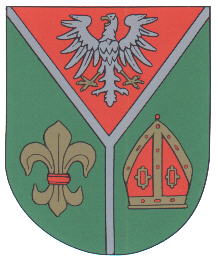Ostprignitz-Ruppin: Difference between revisions
Jump to navigation
Jump to search
Knorrepoes (talk | contribs) m (Text replacement - "/Arms of " to "/Arms (crest) of ") |
Knorrepoes (talk | contribs) m (Text replacement - "{{media}}" to " {{de1}} {{media1}}") |
||
| Line 23: | Line 23: | ||
The eagle is derived from the arms of the Counts of Arnstein, who were the first German rulers of Ruppin in the 13<sup>th</sup> century. The fleur-de-lis is derived from the arms of the Lords of Plotho, first Lords of Kyritz, The mitre is taken as a symbol for Wittstock, which developed when Bishop Heinrich I made the city his capital. | The eagle is derived from the arms of the Counts of Arnstein, who were the first German rulers of Ruppin in the 13<sup>th</sup> century. The fleur-de-lis is derived from the arms of the Lords of Plotho, first Lords of Kyritz, The mitre is taken as a symbol for Wittstock, which developed when Bishop Heinrich I made the city his capital. | ||
{{ | |||
{{de1}} | |||
{{media1}} | |||
[[Civic Heraldry Literature - Germany|'''Literature''']]: Linder and Olzog, 1996 | [[Civic Heraldry Literature - Germany|'''Literature''']]: Linder and Olzog, 1996 | ||
Revision as of 12:20, 26 December 2022
This page is part of the German heraldry portal |
Heraldry of the World |
|
German heraldry:
|
Selected collector's items from Germany:
|
OSTPRIGNITZ-RUPPIN (OPR)
State : Brandenburg
Additions : 1993 Kyritz, Neuruppin, Wittstock
| German | |
| English | No blazon/translation known. Please click here to send your (heraldic !) blazon or translation |
Origin/meaning
The arms were granted on May 2, 1995.
The eagle is derived from the arms of the Counts of Arnstein, who were the first German rulers of Ruppin in the 13th century. The fleur-de-lis is derived from the arms of the Lords of Plotho, first Lords of Kyritz, The mitre is taken as a symbol for Wittstock, which developed when Bishop Heinrich I made the city his capital.
Literature: Linder and Olzog, 1996


